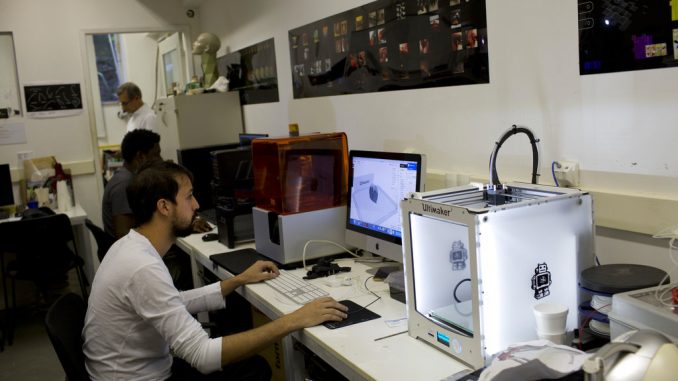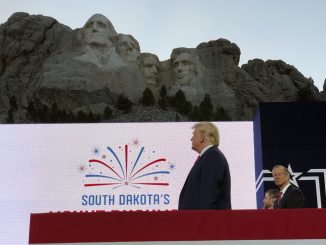
WATERTOWN, S.D. — 3D printers are cranking out all kind of plastic items these days — auto parts, jewelry, tools, to name a few.
In Watertown, they’ve even created a few heroes.
Brooks Jacobsen at Lake Area Technical College and Mark Iverson at the Watertown Middle School teach 3D printing among the many other science-related topics.
When the coronavirus began taking its toll on Americans last March, Jacobsen noticed how others nationally and internationally were using 3D printers to produce personal protective equipment, items in critically short supply across the U.S.
Jacobsen initiated the idea of creating face shields and received approval from LATC officials. Healthcare workers at Prairie Lakes Healthcare System gave him input on the type of face shield they preferred.
“I put out an email to our 3D printing community here in town,” Jacobsen told the Watertown Public Opinion. “A bunch of people had printers at home, and I already knew Mark. He’s been part of the 3D printer club and all sorts of stuff for years. That’s kind of what got us going.”
Five months later, the volunteers had created 37,000 to 40,000 face shields that went to the frontline heroes of the pandemic — the healthcare workers who daily risk their well being while caring for the sick and the dying.
“It’s a surreal thing,” Iverson said. “It’s a hobby of mine that I teach to students, and then it turns around to be something that’s saving lives. It was something that I enjoy doing anyway, and it was actually going to a good cause.”
The number of face shields created is one thing. The steps they took, the resolve they showed and the help they received is also notable.
The face shields weren’t complex, consisting of a forehead band to which a clear plastic shield could be attached, an elastic cord and an ear saver. The rubberized ear saver was connected to the cord and placed at the back of the head so the cord wouldn’t rub on a user’s ears. The forehead band was the object created by 3D printers.
Iverson started with five printers in his house. A $3,000 grant from the Watertown Area Community Foundation allowed him to expand to around 20, which he moved to the middle school. The printers cost about $250 each.
“It turned pretty quickly into a huge, huge operation,” said Iverson. “I think Brooks had about 36 printers going during this whole thing. He was the driving force behind it.”
There were others. J.J. Clendenin at the Watertown Intermediate School and Bob Poor at LATC each had a few printers and contributed in other ways, as did Travis Lage, a friend of Iverson who teaches in Harrisburg. Others in Watertown, Brookings and other locations also assisted.
Many of the printers operated 24/7, needing an occasional refill of the plastic filament needed to created the head bands. Ten headbands would take about eight hours to complete.
Sometimes, life got in the way.
“I was doing 3D printing and still teaching 165 kids through online learning,” said Iverson about last spring. “Plus, I was homeschooling my own four kids. It was a nuthouse.”
Another early problem was finding clear plastic for the shields.
“As soon as people found out about this thing, we started scrounging plastic from anywhere we could,” said iverson. “Teachers were donating their old transparencies from overhead projectors or taking 3-hole divider tab things and cutting those apart. It was literally from anywhere we could find any type of clear plastic.”
The group created a Facebook page and began getting noticed. Their first order was for 5,000 face shields from the S.D. Department of Health.
But interest quickly grew, and much needed support came from different businesses. When needed, Falcon Plastics of Brookings would send 600 ear savers. Fargo Additive Manufacturing Equipment 3D provided the plastic filament, and Raven Industries of Sioux Falls, through experimentation, produced thinner clear plastic than it needed and donated it to Jacobsen.
Jacobsen used lasers at LATC’s LAB building to cut the clear plastic and bore the four holes needed for attaching the shield to the headband. Iverson relied on a 3-hole punch to perforate the lighter plastic material until he eventually ran out of supply and switched to what Jacobsen had obtained.
The final product wasn’t assembled in Watertown. To save on shipping costs, the pieces would be placed in smaller boxes and the recipients would take the short time needed to snap the parts together.
The Watertown group’s only request was that the recipients pay shipping costs.
“We put together an Amazon Shopping Cart, shared it on Facebook, and people from across the nation were buying stuff for us,” said Iverson, who recognized the kindness of the donations but knew scant few of the contributors.
Some of the recipients’ reactions came straight from the heart.
“There were a couple of nurses who sent me emails who said that when they opened the boxes they just cried because they finally had something to protect themselves with,” said Iverson. “We got a lot of messages of thanks and praise.”
Other reports were similar to what was being reported nationally, about doctors and nurses being overwhelmed by thousands of patients who needed testing and care.
“You had nurses talking about how they were treating people in hallways,” Iverson said. “They didn’t have room for ventilators. They even mentioned the bodies. It was absolute carnage, and then to not have any protection.”
Eventually, the need began to subside, and the teachers needed to prepare for upcoming classes. Iverson, however, recently completed an order for another 1,000 face shields.
Jacobsen’s efforts were aided by an intern and work study students. He estimates he has about 2,600 face shields still available.
“That was our goal, to get a big stockpile because I needed the printers for one of my classes,” Jacobsen said. “We print a lot of stuff in our classes.”
The only profit for the volunteers was perhaps the richest — the knowledge they had helped those in need. Their face shields went to as many as 18 states.
“We didn’t make a dime,” said Iverson. “We probably spent more money than we should have. But all the messages of thanks and praise … it was pretty cool.”


